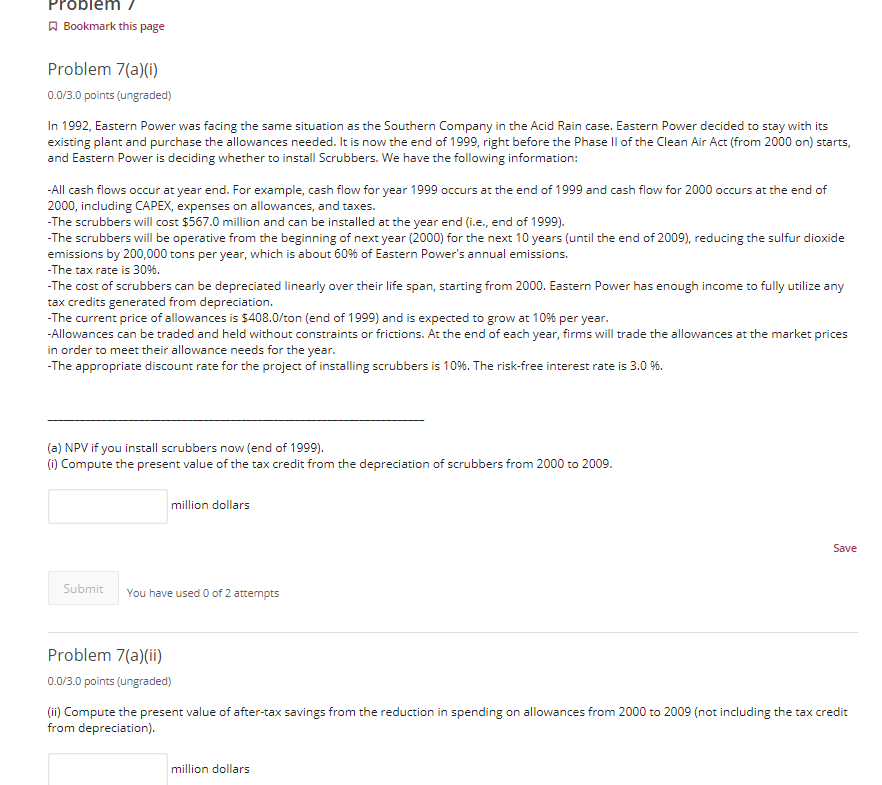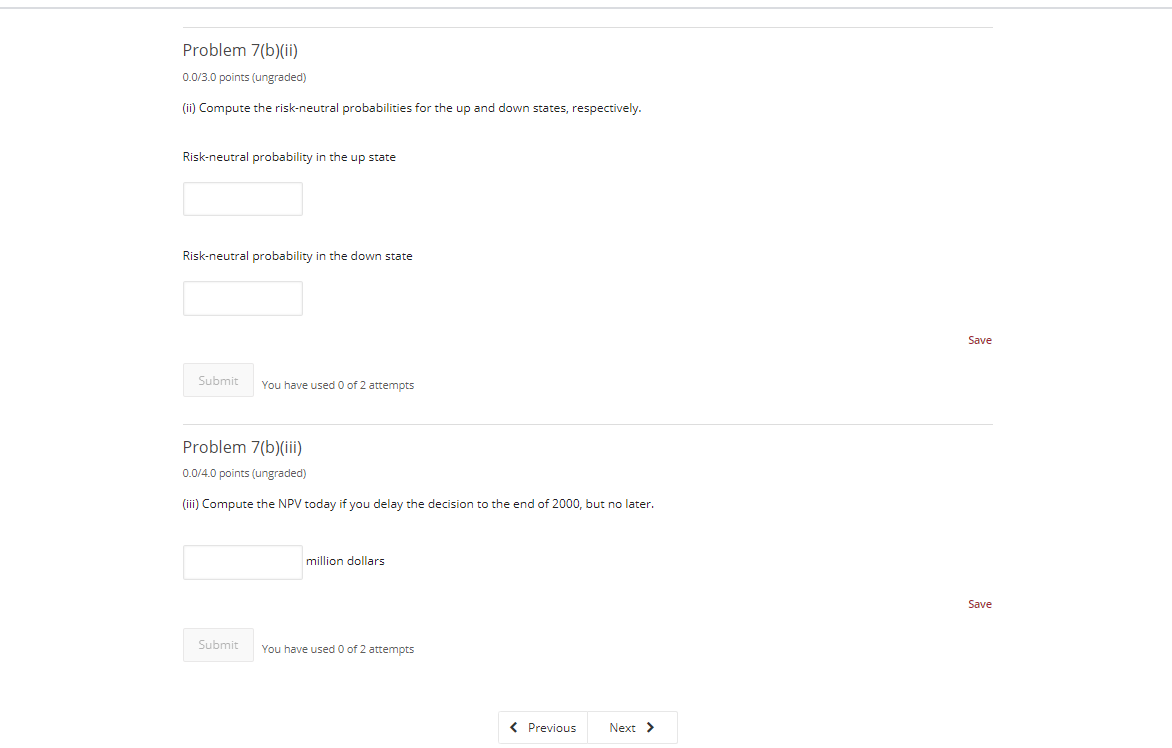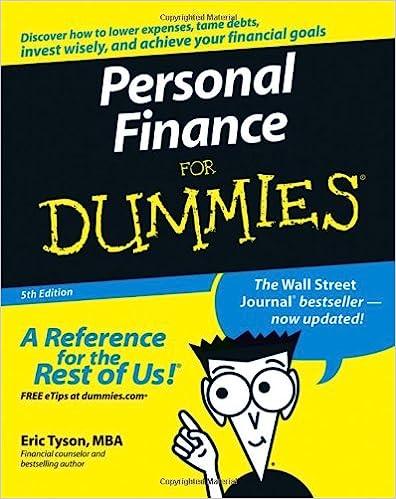


Problem Bookmark this page Problem 7(a)(0) 0.0/3.0 points (ungraded) In 1992, Eastern Power was facing the same situation as the Southern Company in the Acid Rain case. Eastern Power decided to stay with its existing plant and purchase the allowances needed. It is now the end of 1999, right before the Phase Il of the Clean Air Act (from 2000 on) starts, and Eastern Power is deciding whether to install Scrubbers. We have the following information: -All cash flows occur at year end. For example, cash flow for year 1999 occurs at the end of 1999 and cash flow for 2000 occurs at the end of 2000, including CAPEX, expenses on allowances, and taxes. -The scrubbers will cost $567.0 million and can be installed at the year end (i.e., end of 1999). -The scrubbers will be operative from the beginning of next year (2000) for the next 10 years (until the end of 2009), reducing the sulfur dioxide emissions by 200,000 tons per year, which is about 60% of Eastern Power's annual emissions. -The tax rate is 30%. - The cost of scrubbers can be depreciated linearly over their life span, starting from 2000. Eastern Power has enough income to fully utilize any tax credits generated from depreciation. - The current price of allowances is $408.0/ton (end of 1999) and is expected to grow at 10% per year. -Allowances can be traded and held without constraints or frictions. At the end of each year, firms will trade the allowances at the market prices in order to meet their allowance needs for the year. -The appropriate discount rate for the project of installing scrubbers is 10%. The risk-free interest rate is 3.0 %. (a) NPV if you install scrubbers now (end of 1999). (1) Compute the present value of the tax credit from the depreciation of scrubbers from 2000 to 2009. million dollars Save Submit You have used 0 of 2 attempts Problem 7(a)(ii) 0.0/3.0 points (ungraded) (ii) Compute the present value of after-tax savings from the reduction in spending on allowances from 2000 to 2009 (not including the tax credit from depreciation). million dollars Problem 7(a)(iii) 0.0/4.0 points (ungraded) (iii) Compute the NPV of installing scrubbers now. million dollars Save Submit You have used 0 of 2 attempts Problem 7(b)(0) 0.0/4.0 points (ungraded) (b) Your further analysis of the market shows that there is significant uncertainty about the price of allowances, which will be resolved right before the end of next year (end of 2000). The price of allowances may go up to $528.0/ton with probability 7/10 or drop to $265.0/ton with probability 3/10. The price of allowances is still expected to increase at 10% per year thereafter, with usual uncertainty. Suppose that you delay your decision to next year (end of 2000). Compute the NPV at the end of 2000 for installing the scrubbers then, in the up state, when the price of allowances goes up to $528.0/tons and down state, in which the price of allowances goes down to $265.0/ton, respectively. NPV in the up state million dollars NPV in the down state million dollars Save Submit You have used 0 of 2 attempts Problem 7(b)(ii) 0.0/3.0 points (ungraded) (ii) Compute the risk-neutral probabilities for the up and down states, respectively. Risk-neutral probability in the up state Risk-neutral probability in the down state Save Submit You have used 0 of 2 attempts Problem 7(b)(iii) 0.0/4.0 points (ungraded) (iii) Compute the NPV today if you delay the decision to the end of 2000, but no later. million dollars Save Submit You have used 0 of 2 attempts Problem Bookmark this page Problem 7(a)(0) 0.0/3.0 points (ungraded) In 1992, Eastern Power was facing the same situation as the Southern Company in the Acid Rain case. Eastern Power decided to stay with its existing plant and purchase the allowances needed. It is now the end of 1999, right before the Phase Il of the Clean Air Act (from 2000 on) starts, and Eastern Power is deciding whether to install Scrubbers. We have the following information: -All cash flows occur at year end. For example, cash flow for year 1999 occurs at the end of 1999 and cash flow for 2000 occurs at the end of 2000, including CAPEX, expenses on allowances, and taxes. -The scrubbers will cost $567.0 million and can be installed at the year end (i.e., end of 1999). -The scrubbers will be operative from the beginning of next year (2000) for the next 10 years (until the end of 2009), reducing the sulfur dioxide emissions by 200,000 tons per year, which is about 60% of Eastern Power's annual emissions. -The tax rate is 30%. - The cost of scrubbers can be depreciated linearly over their life span, starting from 2000. Eastern Power has enough income to fully utilize any tax credits generated from depreciation. - The current price of allowances is $408.0/ton (end of 1999) and is expected to grow at 10% per year. -Allowances can be traded and held without constraints or frictions. At the end of each year, firms will trade the allowances at the market prices in order to meet their allowance needs for the year. -The appropriate discount rate for the project of installing scrubbers is 10%. The risk-free interest rate is 3.0 %. (a) NPV if you install scrubbers now (end of 1999). (1) Compute the present value of the tax credit from the depreciation of scrubbers from 2000 to 2009. million dollars Save Submit You have used 0 of 2 attempts Problem 7(a)(ii) 0.0/3.0 points (ungraded) (ii) Compute the present value of after-tax savings from the reduction in spending on allowances from 2000 to 2009 (not including the tax credit from depreciation). million dollars Problem 7(a)(iii) 0.0/4.0 points (ungraded) (iii) Compute the NPV of installing scrubbers now. million dollars Save Submit You have used 0 of 2 attempts Problem 7(b)(0) 0.0/4.0 points (ungraded) (b) Your further analysis of the market shows that there is significant uncertainty about the price of allowances, which will be resolved right before the end of next year (end of 2000). The price of allowances may go up to $528.0/ton with probability 7/10 or drop to $265.0/ton with probability 3/10. The price of allowances is still expected to increase at 10% per year thereafter, with usual uncertainty. Suppose that you delay your decision to next year (end of 2000). Compute the NPV at the end of 2000 for installing the scrubbers then, in the up state, when the price of allowances goes up to $528.0/tons and down state, in which the price of allowances goes down to $265.0/ton, respectively. NPV in the up state million dollars NPV in the down state million dollars Save Submit You have used 0 of 2 attempts Problem 7(b)(ii) 0.0/3.0 points (ungraded) (ii) Compute the risk-neutral probabilities for the up and down states, respectively. Risk-neutral probability in the up state Risk-neutral probability in the down state Save Submit You have used 0 of 2 attempts Problem 7(b)(iii) 0.0/4.0 points (ungraded) (iii) Compute the NPV today if you delay the decision to the end of 2000, but no later. million dollars Save Submit You have used 0 of 2 attempts









